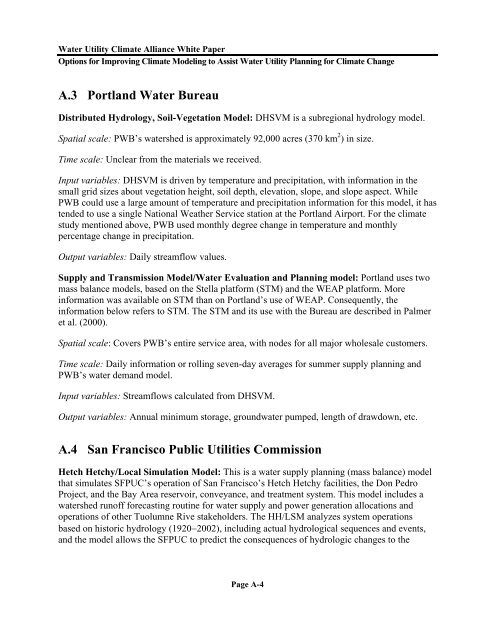Options for Improving Climate Modeling to Assist Water Utility ...
Options for Improving Climate Modeling to Assist Water Utility ...
Options for Improving Climate Modeling to Assist Water Utility ...
Create successful ePaper yourself
Turn your PDF publications into a flip-book with our unique Google optimized e-Paper software.
<strong>Water</strong> <strong>Utility</strong> <strong>Climate</strong> Alliance White Paper<br />
<strong>Options</strong> <strong>for</strong> <strong>Improving</strong> <strong>Climate</strong> <strong>Modeling</strong> <strong>to</strong> <strong>Assist</strong> <strong>Water</strong> <strong>Utility</strong> Planning <strong>for</strong> <strong>Climate</strong> Change<br />
A.3 Portland <strong>Water</strong> Bureau<br />
Distributed Hydrology, Soil-Vegetation Model: DHSVM is a subregional hydrology model.<br />
Spatial scale: PWB’s watershed is approximately 92,000 acres (370 km 2 ) in size.<br />
Time scale: Unclear from the materials we received.<br />
Input variables: DHSVM is driven by temperature and precipitation, with in<strong>for</strong>mation in the<br />
small grid sizes about vegetation height, soil depth, elevation, slope, and slope aspect. While<br />
PWB could use a large amount of temperature and precipitation in<strong>for</strong>mation <strong>for</strong> this model, it has<br />
tended <strong>to</strong> use a single National Weather Service station at the Portland Airport. For the climate<br />
study mentioned above, PWB used monthly degree change in temperature and monthly<br />
percentage change in precipitation.<br />
Output variables: Daily streamflow values.<br />
Supply and Transmission Model/<strong>Water</strong> Evaluation and Planning model: Portland uses two<br />
mass balance models, based on the Stella plat<strong>for</strong>m (STM) and the WEAP plat<strong>for</strong>m. More<br />
in<strong>for</strong>mation was available on STM than on Portland’s use of WEAP. Consequently, the<br />
in<strong>for</strong>mation below refers <strong>to</strong> STM. The STM and its use with the Bureau are described in Palmer<br />
et al. (2000).<br />
Spatial scale: Covers PWB’s entire service area, with nodes <strong>for</strong> all major wholesale cus<strong>to</strong>mers.<br />
Time scale: Daily in<strong>for</strong>mation or rolling seven-day averages <strong>for</strong> summer supply planning and<br />
PWB’s water demand model.<br />
Input variables: Streamflows calculated from DHSVM.<br />
Output variables: Annual minimum s<strong>to</strong>rage, groundwater pumped, length of drawdown, etc.<br />
A.4 San Francisco Public Utilities Commission<br />
Hetch Hetchy/Local Simulation Model: This is a water supply planning (mass balance) model<br />
that simulates SFPUC’s operation of San Francisco’s Hetch Hetchy facilities, the Don Pedro<br />
Project, and the Bay Area reservoir, conveyance, and treatment system. This model includes a<br />
watershed runoff <strong>for</strong>ecasting routine <strong>for</strong> water supply and power generation allocations and<br />
operations of other Tuolumne Rive stakeholders. The HH/LSM analyzes system operations<br />
based on his<strong>to</strong>ric hydrology (19202002), including actual hydrological sequences and events,<br />
and the model allows the SFPUC <strong>to</strong> predict the consequences of hydrologic changes <strong>to</strong> the<br />
Page A-4

















